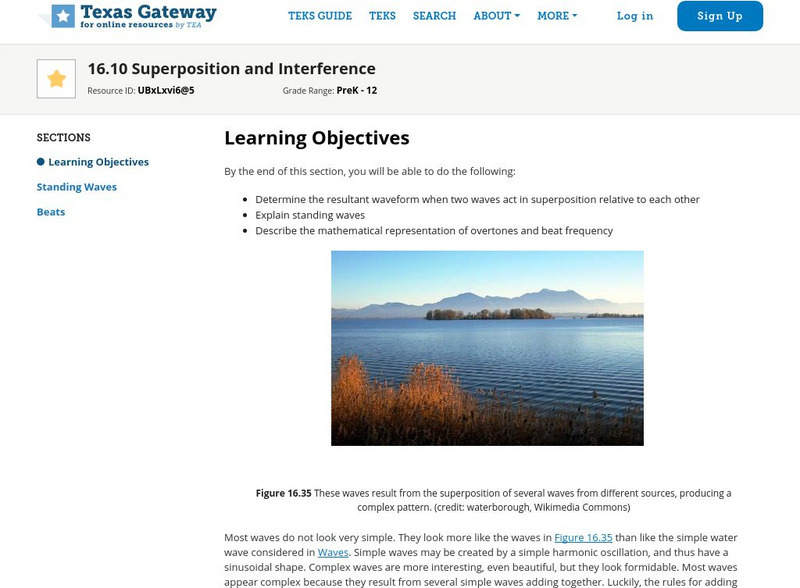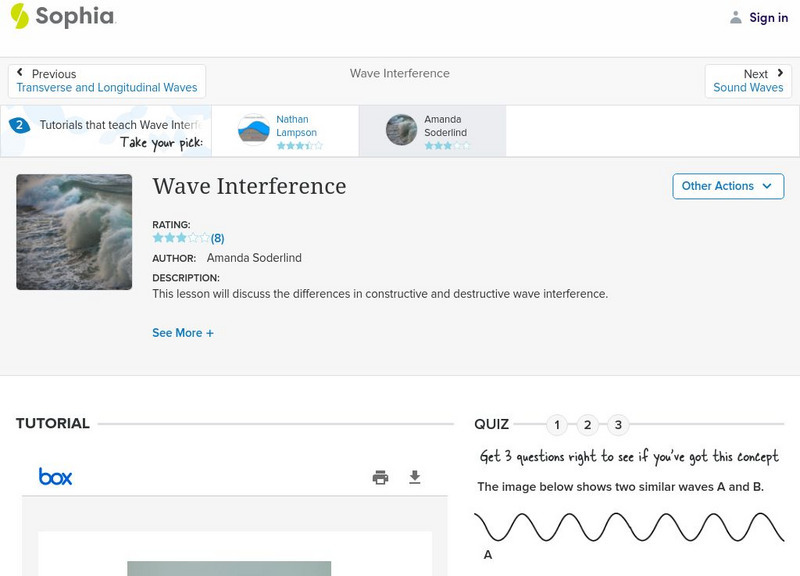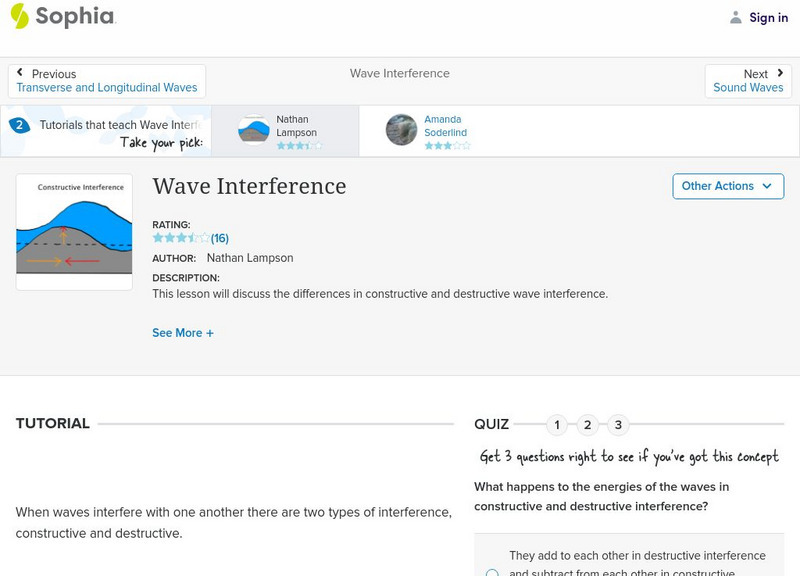Curated OER
Wave Phenomena and the Electromagnetic Spectrum
Science learners scrutinize shadow size and quality, and experiment with diffraction. They model superposition of electromagnetic waves, and experiment with interference. These activities are action-packed and challenging for your...
Georgia Department of Education
Ga Virtual Learning: Electromagnetic Waves and the Wave Nature of Light
In this interactive lesson about electromagnetic waves students will explore what they can see, what they can't, and what they know about the wave nature of this thing called "light."
Khan Academy
Khan Academy: The Quantum Mechanical Model of the Atom
An explanation using quantum mechanics to describe the atom.
TeachEngineering
Teach Engineering: Learning Light's Properties
Students learn the basic properties of light--the concepts of light absorption, transmission, reflection and refraction, as well as the behavior of light during interference. Lecture information briefly addresses the electromagnetic...
Physics Classroom
The Physics Classroom: Formation of Standing Waves
How are standing wave formations formed? Why are they only formed when the medium is vibrated at specific frequencies? What makes these so-called frequencies so special and magical? These questions are answered in this exploration of...
Physics Classroom
The Physics Classroom: Light Waves and Color
The behavior of light waves is introduced and discussed. Also, polarization, color, diffraction, and interference are introduced and discussed thoroughly as supporting evidence of the wave nature of light.
Vision Learning
Visionlearning: Physics: Light I: Particle or Wave
Instructional module focusing on light. Discussion includes historical development of particle versus wave theories and the scientific studies leading to the understanding of light waves today. Site also includes an interactive practice...
Texas Education Agency
Texas Gateway: Superposition and Interference
By the end of this section, you will be able to determine the resultant waveform when two waves act in superposition relative to each other, explain standing waves, and describe the mathematical representation of overtones and beat...
CK-12 Foundation
Ck 12: Diffraction
[Free Registration/Login may be required to access all resource tools.] Students investigate diffraction of light and the interference patterns that are produced through constructive and destructive interference of the waves. Students...
Exploratorium
Exploratorium: Bubbularium
What colors do you see in a bubble? Why do you see colors in a bubble? Use this site to find out the answer to these questions with this easy experiment.
Georgia State University
Georgia State University: Hyper Physics: Interference of Sound
Information about the interference of sound and its causes. Well-illustrated and good explanations of the concepts; part of a large hyper-textbook on various physics concepts.
Georgia State University
Georgia State University: Hyper Physics: Refraction of Sound
A discussion of refraction and its application to sound waves. Using analogies, graphics and real-life applications, this page and those that accompany it explain why and when sound waves bend.
Exploratorium
Exploratorium: Science Snacks: Soap Film Painting
Investigate the constructive and destructive interference of waves as they reflect off the front and back surfaces of soap film. See what colorful effects can be created on a large, vertical soap film surface where gravity comes into play.
Physics Classroom
The Physics Classroom: Two Point Source Interference
This lesson from the Glenbrook South High School discusses two-point source interference. It gives detail on the difference between constructive and destructive interference, what a two-point source interference is and what happens when...
CK-12 Foundation
Ck 12: Physical Science: Wave Interference
[Free Registration/Login may be required to access all resource tools.] What wave interference is, constructive and destructive interference and how standing waves occur.
Physics Classroom
The Physics Classroom: Waves: Formation of Standing Waves
Through illustrated examples and animations, students investigate the formation of standing waves.
Physics Classroom
The Physics Classroom: Sound Waves and Music: Interference and Beats
Illustrated diagrams and interactive practice problems show constructive and destructive interference occurring at sound beats.
Physics Classroom
The Physics Classroom: Light Waves/ Color: Other Two Point Source Interference
Where can we experience the phenomenon that light taking two paths from two locations to the same point in space can undergo constructive and destructive interference? There are several answers to these questions and they will be...
Physics Aviary
Physics Aviary: Distance to Destruction Lab
This lab is designed to help students visualize distance between two synchronized sources that will lead to constructive and destructive interference.
BBC
Bbc: Gcse Bitesize: Why Do Scientists Think That Light and Sound Are Waves?
Light travels as transverse waves and can travel through a vacuum. Sound travels as longitudinal waves and needs to travel through a solid, liquid or gas. Read about the properties of light and of sound, and learn the differences between...
Sophia Learning
Sophia: Wave Interference: Lesson 2
This lesson will discuss the differences in constructive and destructive wave interference. It is 2 of 2 in the series titled "Wave Interference."
Sophia Learning
Sophia: Wave Interference: Lesson 1
This lesson will discuss the differences between constructive and destructive wave interference. It is 1 of 2 in the series titled "Wave Interference."

















